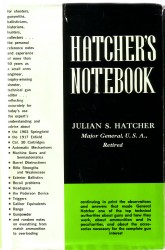Firearms Technical Trivia, June 2000:
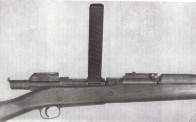 |
 |
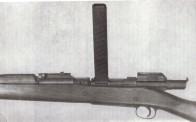 |
Ask any firearms aficionado to name the firearms issued to United States forces during the First World War, and some very familiar names will be mentioned. You'll hear about the M1903 Springfield, the M1917 Enfield, the BAR, and the M1911 pistol. You might even hear of the M1917 revolvers made by either Smith & Wesson or Colt. What you are unlikely to hear about, however is the "Automatic Pistol, Caliber .30, Model of 1918," also known as the "Pedersen Device." Some 65,000 of these were made by the end of the First World War. The story behind this weapon was one of the best kept secrets of the War, and one that bears telling. . . .
Despite the name, the weapon in question, which is better known as the "Pedersen Device," was not an automatic pistol at all, but a replacement bolt for the Springfield M1903 rifle that allowed the rifle to function as a self loader. It was designed to take a magazine holding forty rounds. The cartridges are of same .30 caliber diameter as the rifle, but the cases were more akin to the .32 ACP cartridge in size and shape, albeit slightly longer (the Pedersen Device cartridges are identical to the French .32 Longue service cartridge).
In the summer of 1917, J.D. Pedersen, a well known firearms designer and inventor, came to the War Department and presented himself to the chief of the Small Arms Division. To this august officer Mr. Pedersen reported that he had what he considered to be a very important invention, which he wished to have reviewed in secret. Because of Mr. Pedersen's fame, his request was agreed to, and when the device was demonstrated at the Congress Heights Rifle Range in Washington, D.C., only one or two senior War Department officials were present. Pedersen began his demonstration by firing a Springfield rifle. After firing two or three shots, he quickly removed the bolt from the rifle and dropped it into a pouch held on his waist. From a scabbard on his belt, Pedersen took a long tubular piece of metal and slid it home in the rifle's bolt raceways, and locked it into place with the rifle's bolt locking mechanism, by turning down the magazine cut-off. Then he clicked a long black magazine into place, and began firing the rifle as fast as he could pull the trigger.
One can only imagine how surprised the War Department officials were. After all, the Springfield was a bolt action rifle that required significant effort and manipulation on behalf of the shooter to ready the rifle for the next shot. With Pedersen's device installed, the effort of reloading was completed automatically in an instant, and the rifle could be fired again. It must have looked as if the rifle had been converted into a machine gun! Closer examination revealed that the cartridge was only about one - fifth the size of the caliber .30 M1906 rifle cartridge, though the bullet was of the same diameter. The automatic bolt was functionally the same as a blowback pistol, with a barrel that was the exact size, shape and length of the caliber .30 M1906 cartridge case. The interior of the barrel was rifled with very fine rifling that was larger in diameter than that of the Springfield rifle's barrel. This is done so that the rifling in the small barrel need not mate exactly with the rifling in the rifle's barrel.
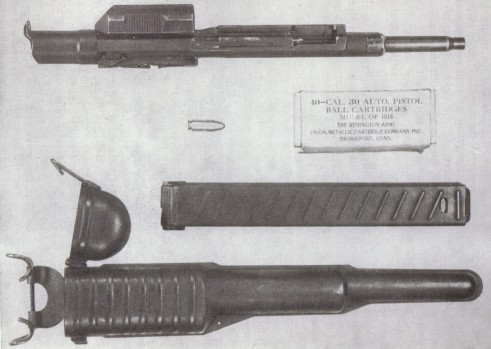
Pedersen Device and Accessories Image Credit: Hatcher, Julian S., Hatcher's Notebook, Stackpole Books (Harrisburg, Pennsylvania: 1966) Page 364 |
The device is locked in place in the rifle's receiver by the regular magazine cut off. On the upper right hand part of the device, near the front of the rifle's receiver opening was a spring catch which held the long magazine, which slanted up and to the right at about a 45 degree angle. Fired cases were ejected through a port on the left side of the device, and through a corresponding port cut in the left receiver wall of the rifle. Not only must rifles modified for the device have the cut in the left receiver wall, but they must also have |
| When one looks at a Pedersen Device, the most salient characteristic is the hump on top. This weight, which reciprocates with the device's operating parts, is designed to add the necessary mass to the breech so that a more powerful cartridge may be used (the Pedersen Device cartridge has a |
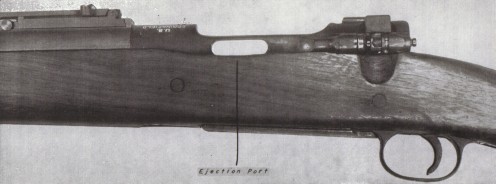
Springfield M1903 Mk. I Rifle Image Credit: Hatcher, Julian S., Hatcher's Notebook, Stackpole Books (Harrisburg, Pennsylvania: 1966) Page 368 |
The Pedersen Device fired a cartridge with an eighty grain bullet atop three and a half grains of powder, producing, as was mentioned above, some 1,300 fps muzzle velocity. What does this mean, ballistically speaking? A projectile's energy depends on the square of the velocity as well as bullet weight. As a result, the the Pedersen cartridge develops approximately one tenth the muzzle energy of the 150 grain, 2,800 foot per second .30-06 cartridge. This was judged to be sufficiently lethal, however at ranges up to 500 yards. With respect to penetration, the .30-06 will penetrate 60 inches of wood eight feet from the muzzle, while the Pedersen round will only penetrate 8 inches or so. Again, this was determined to be of sufficient lethality.
The tactical vision for the Pedersen Device was straightforward. An attack by the enemy on an American trench system would be met by a whirlwind of fire, each American soldier firing what amounted to a miniature machine gun, through which no attack could survive. Conversely, the ideas for using the device in the attack were no less grandiose. Since the Pedersen Device had very slight recoil, it could be fired from the hip while walking or running. A line of soldiers advancing across no-man's land, firing the Pedersen Device at the enemy trenches would make it extremely dangerous for anyone in the enemy trenches to show any part of his anatomy. Of course, fire delivered while walking or running would not be very accurate, but the tremendous volume of fire would make up for the inaccuracy, and the enemy trenches would be smothered with the storm of bullets. That was the plan at any rate.
The device was readily interchangeable with the regular Springfield bolt, thus enabling the replacement of the regular bolt at will. It was envisioned that the soldier would go into battle carrying his basic load of .30-06 cartridges, and in addition, he would carry the device in a scabbard on his belt along with a canvas pouch to store the regular rifle bolt while the device was in use. He would also carry a canvas case holding ten forty round magazines.
When General Pershing, the commander of the American Expeditionary Force in Europe during World War One heard about the device, he sent a coded cablegram asking for the earliest possible production of 100,000 of the devices, and asking that the program be classified at the highest levels. And thus, the Pedersen Device was placed into production as the "Automatic Pistol, Caliber .30, Model of 1918." This of course led to some amusing anecdotes. Some writers who heard of the device being referred to by this misinformative nomenclature roundly criticized the War Department for adopting a new small caliber pistol as the M1911 pistol was more than capable of doing the job assigned! A serious tactical employment study was undertaken, wherein it was determined that 500,000 Pedersen Devices could be ready to go to France for a surprise offensive in the spring of 1919. However, this plan was effectively overtaken by events, as the war ended in November 1918, with 65,000 Pedersen Devices completed. Remaining orders were canceled.
After the armistice that ended World War One, a study was conducted of future uses for the device. One of the tests for this study was conducted at LeMans, France, and was attended by General Pershing and senior members of his staff. The test was conducted as a competition between two squads of designated marksmen, one with standard Springfield rifles and one with Pedersen Device rifles. A number of silhouette targets were set up for each squad. The squads started firing at 1,000 yards, from the prone position, firing until a certain number of hits had been attained. The two squads, using the rifles in standard configuration moved forward at about equal speed until they were about 600 yards from the targets. At this distance, the squad with the Pedersen Devices swapped bolts and began using the self loading bolt. They were able to deliver such a volume of fire at all distances to the objective that they had attained the objective before the squad using standard rifles had left the 600 yard line.
So why wasn't the Pedersen Device adopted in large numbers as a standard US infantry weapon? The answer lies in the tactical analyses that followed the war. In light of the trench warfare situation that characterized the First World War, the Pedersen Device had definite tactical applications and advantages which outweighed any system disadvantages. However, in a fluid, mobile conflict of maneuver, the system's disadvantages became telling:
As a result of these disadvantages, a few years after the end of the First Word War, the Army stopped funding the storage of the remaining Pedersen Devices, and they were all destroyed. The Mark I rifles were converted back to regular service rifle configuration by the removal of the special sear and cut off. The ejection port remained, as did the receiver markings. Many of the Mark I rifles are now in private hands, and they often evince strange responses at the range from folks who have never heard of the Pedersen Device. Interestingly, the French were sufficiently enamored of the device's cartridge to adopt it as their standard service pistol cartridge until 1950.
- Because of the projectile's comparatively light weight and low power, it was effective against individual targets only out to about 350 yards. Beyond that range, only mass fire could be depended upon. In addition, the trajectory of the Pedersen round was such that if it were sighted to hit a man at 500 yards, it would pass cleanly over the head of a man at 300 yards.
- The additional weight to the infantryman's basic load was considered to be detrimental to effective maneuver.
- The danger that soldiers would lose either the Pedersen or the regular Springfield bolts during the changeover due to the exigencies of combat was deemed to be greater than previously thought.
Note: Data for this month's trivia page was gathered from:
Hatcher's Notebook, by Major General Julian S. Hatcher, United States Army, Retired, Stackpole Books, Harrisburg, Pennsylvania, 1966. ISBN 0-8117-0795-4)
Hatcher's
Notebook is available from Amazon.com. Click on the image to
order.
